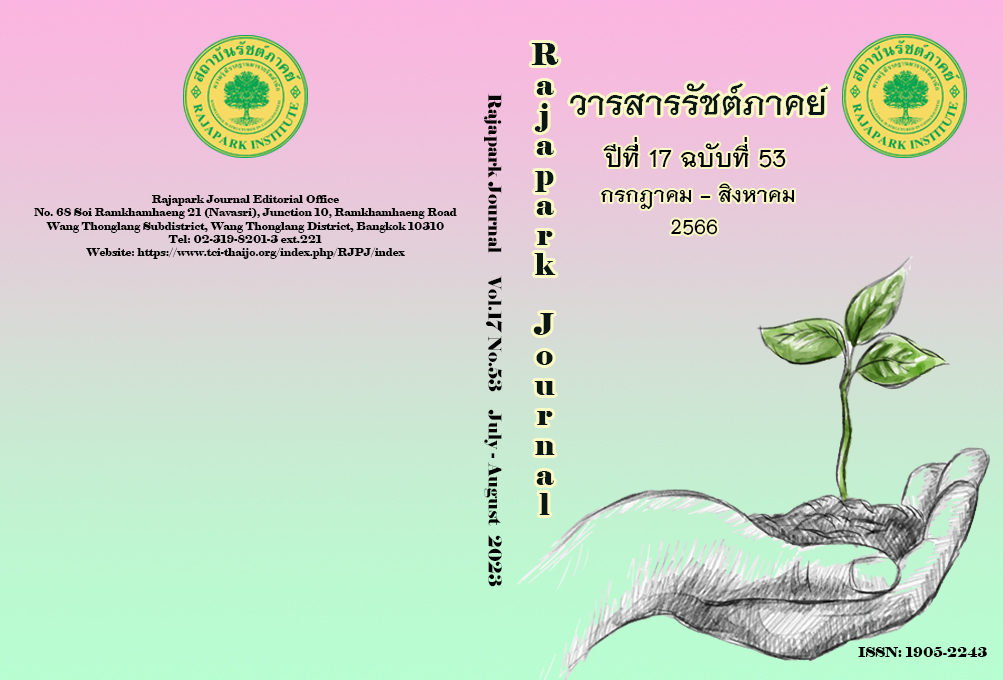Wellness Tourism Activities Development of Ban Sawai So, Buri Ram Province
Main Article Content
Abstract
The objectives of this research were: 1) to study the potential and management of Ban Sawai So community-based wellness tourism; 2) to study the motivation of tourists toward Ban Sawai So community-based wellness tourism activities; and 3) to develop wellness tourism activities in Ban Sawai So Community. Mixed Methods Research was used by defining the research methodology in 3 phases: 1) a study of basic data to design community-based wellness tourism activities; 2) designing community-based wellness tourism activities; and 3) an experiment and assessment of community-based wellness tourism activities. The study was conducted on stakeholders in the development of wellness tourism activities by the Ban Sawai So community and tourists. The researchers used focus groups, questionnaires, and lessons learned to analyze activity development. The results showed that Ban Sawai So community had natural and cultural resources that could be further developed into wellness tourism activities, and Ban Sawai Sor Organic Rice Group plays a major role in the development of these activities. Motivation of tourists towards organizing wellness tourism activities by the Ban Sawai So community, it was found that the overall motivation was at a high level ( = 4.05, S.D. = 0.491). From the results of experimental and evaluation activities, it was found that all activities had higher than expected outcomes with statistical significance at the 0.05 level and the overall satisfaction at the highest level (
= 4.51, S.D. = 0.388).
Article Details

This work is licensed under a Creative Commons Attribution-NonCommercial-NoDerivatives 4.0 International License.
Views and opinions appearing in the Journal it is the responsibility of the author of the article, and does not constitute the view and responsibility of the editorial team.
References
Árpási, Z. (2018). Wellness Tourism: What Motivates the Consumer. Valahian Journal of Economic Studies, 9(1), 87-92. https://www.researchgate.net/publication/329406664_Wellness_Tourism_What_Motivates_the_Consumer
Buri Ram Provincial Office. (2020). Buriram Provincial Development Plan (2018-2022) Revision 2020. http://www.buriram.go.th/publish/?p=154
Cochran, W. G. (1953). Sampling Techniques. John Wiley & Sons.
Department of Health Service Support, Ministry of Public Health. (2021). The Journey To Thailand Health Tourism EP.1. http://mrd-hss.moph.go.th/mrd1_hss/wp-content/uploads/2021/09/The-Journey-To-Thailand-Health-Tourism-EP.1.pdf
Dickman, S. (1996). Tourism: An Introductory Text (2nd ed.). Hodder Education.
Future Market Insights. (2021). Tourism Industry Revival on Cards as Special Interest Tourism Set to Rise at 22.4% CAGR: FMI. https://www.futuremarketinsights.com/press-release/special-interest-tourism-sector-overview-and-analysis
Gee, C., Makens, J., & Choy, D. (1997). The Travel Industry. Wiley.
Global Wellness Institute. (2020). 2020 Compendium: Resetting the World with Wellness. https://globalwellnessinstitute.org/industry-research/resetting-the-world-with-wellness/
Goodwin, H., & Santilli, R. (2009). Community-Based Tourism: A success?. ICRT Occasional Paper, 11, 1-37.
Gosset, W. S. (1908, March). The Probable Error of a Meann. Biometrika, 6(1), 1-25.
He Mang., Liu Biqianng., & Li Yaoqi. (2021). Tourist Inspiration: How the Wellness Tourism Experience Inspires Tourist Engagement. Journal of Hospitality & Tourism Research, 1-21. https://journals.sagepub.com/doi/10.1177/10963480211026376
Jittangwattana, B. (2005). Tourism Industry. Press and Design.
Leksuma, P., Dokchan, T., Udomsilp, M., Fakyen, A., & Chuamuangphan, N. (2019). The Guideline of Wellness Tourism Activities Development in Western Thailand. Research and Development Journal Loei Rajabhat University, 14(49), 20-30. https://so05.tci-thaijo.org/index.php/researchjournal-lru/article/view/207005
Nunnally, J. C., & Bernstein, I. H. (1994). Psychometric Theory. McGraw-Hill.
Office of the National Economic and Social Development Council. (2018). The National Strategy (2018-2037). Office of the National Economic and Social Development Council.
Rovinelli, R. J., & Hambleton, R. K. (1976). On the Use of Content Specialists in the Assessment of Criterion-Referenced Test Item Validity. https://eric.ed.gov/?id=ED121845
Royal Thai Government. (2021). A Government Spokesman Said the Prime Minister Order to Push Tourism, Wellness Tourism and Medical Tourism to Support Tourism in the COVID-19 Era. https://www.thaigov.go.th/news/contents/details/48865%20thaihealth.or.th
Siamrath. (2019). Experience the Rice Fields at "Ban Sawai Sor" and See "Thai cranes". https://siamrath.co.th/n/59267
Smith, M. (2013). Prevention is Better than Cure! the Relationship Between Wellness and Medical Approaches to Health. https://www.slideshare.net/CongresPreventieveWe/melani-smith-keynote-spreker-congres-preventieve-wellness
Soonthonsma, V., & Thammachart, P. (2016). Community-Based Healthy Tourism Patterns for Sustainable Development of Community-Based Enterprise Networking in Prajinburi Province. Journal of the Association of Researchers, 21(3), 167-181. http://www.ar.or.th/ImageData/Magazine/10044/DL_10290.pdf
Suansri, P. (2003). Community Based Tourism Handbook. Tourism for Life and Nature Project.
Tourism Authority of Thailand. (2009). Health Tourism. Tourism Authority of Thailand.
Tourism Authority of Thailand. (2021). 9 New Trends in the Future of Tourism. https://api.tourismthailand.org/upload/live/content_article_file/20603-15378.pdf
Watcharapreeda, P. (2016). Guidelines of Developing Health Tourism Management by Communities in Nakhon Phanom Province. In The 13th National Academic Conference, Kasetsart University Kamphaeng Saen Campus (pp. 2453-2461). Nakhon Pathom: Educational Administration Division Kasetsart University Kamphaeng Saen Campus.


